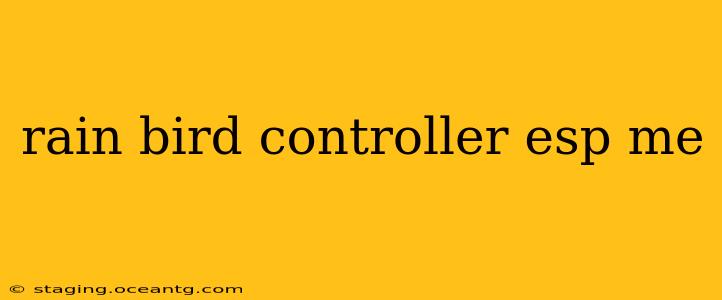The Rain Bird ESP-ME is a popular choice for irrigation control, offering a blend of features and reliability. This comprehensive guide will delve into its capabilities, addressing common questions and providing helpful tips for optimal use. Whether you're a seasoned landscaper or a homeowner tackling your first irrigation project, this guide will equip you with the knowledge to master your Rain Bird ESP-ME.
What are the key features of the Rain Bird ESP-ME?
The Rain Bird ESP-ME boasts several key features that make it stand out:
- Easy Programming: Its intuitive interface simplifies programming, making it user-friendly for both beginners and experienced users. The large, clear display ensures effortless navigation through the various settings.
- Water-Saving Technology: The ESP-ME incorporates advanced features designed to conserve water. These include weather-based adjustments (requires a separate weather sensor) and customizable watering schedules.
- Multiple Programming Options: You can program multiple independent stations, allowing for precise control over different zones in your landscape. This ensures that each area receives the appropriate amount of water.
- Durable Construction: Built to withstand the elements, the ESP-ME is designed for long-lasting performance in various climates.
- Expansion Capabilities: The ESP-ME can be expanded with additional modules to manage larger irrigation systems.
How do I program my Rain Bird ESP-ME controller?
Programming your Rain Bird ESP-ME is straightforward. Consult your controller's manual for detailed instructions specific to your model, but the general steps typically include:
- Setting the Time: Establish the correct time and date for accurate scheduling.
- Defining Watering Days: Select the days of the week you wish to water each zone.
- Setting Watering Times: Determine the duration of watering for each zone, adjusting based on soil type, plant needs, and weather conditions.
- Adjusting for Seasonal Changes: Modify watering schedules throughout the year to accommodate changes in weather and plant requirements.
How do I troubleshoot common problems with my Rain Bird ESP-ME?
Several issues can arise with irrigation controllers. Here's how to address some common problems:
- Controller Not Powering On: Check the power supply, ensuring the controller is properly plugged in and the circuit breaker hasn't tripped.
- Solenoids Not Engaging: Verify that the valves are functioning correctly and that there are no obstructions in the lines.
- Inconsistent Watering: Inspect the system for leaks or clogged emitters, and ensure the water pressure is adequate.
- Incorrect Watering Times: Double-check the programming settings to ensure accuracy.
Can I connect my Rain Bird ESP-ME to a smart home system?
While the Rain Bird ESP-ME doesn't have built-in smart home integration, several third-party solutions exist that allow for remote control and monitoring. These often involve adding a separate device or using a dedicated app. Research options that are compatible with your specific smart home system.
What is the difference between the Rain Bird ESP-ME and other Rain Bird controllers?
The Rain Bird ESP-ME stands out within the Rain Bird lineup due to its balance of features and price. Other models may offer more advanced capabilities, such as integrated weather sensors or more sophisticated programming options, but often at a higher cost. The choice depends on your individual needs and budget.
How do I choose the right Rain Bird ESP-ME model for my needs?
The ESP-ME comes in various configurations, differing primarily in the number of stations they support. Choose a model with enough stations to cover all the zones in your irrigation system. Consider future expansion needs when making your selection.
This comprehensive guide provides a strong foundation for understanding and effectively using your Rain Bird ESP-ME controller. Remember to consult your owner's manual for detailed instructions and troubleshooting tips specific to your model. By understanding its features and capabilities, you can optimize your irrigation system for maximum efficiency and water conservation.
